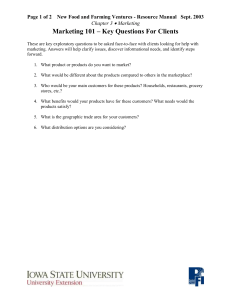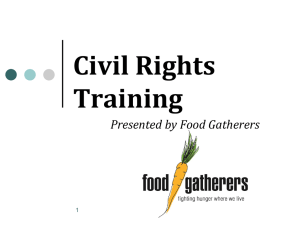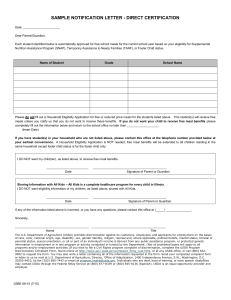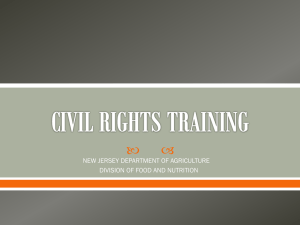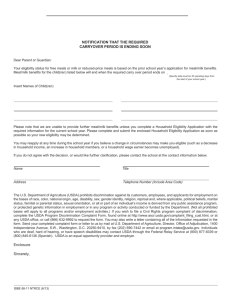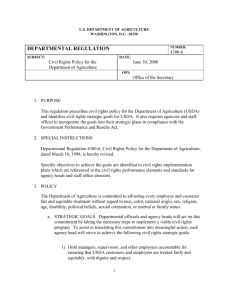Civil Rights Training
advertisement
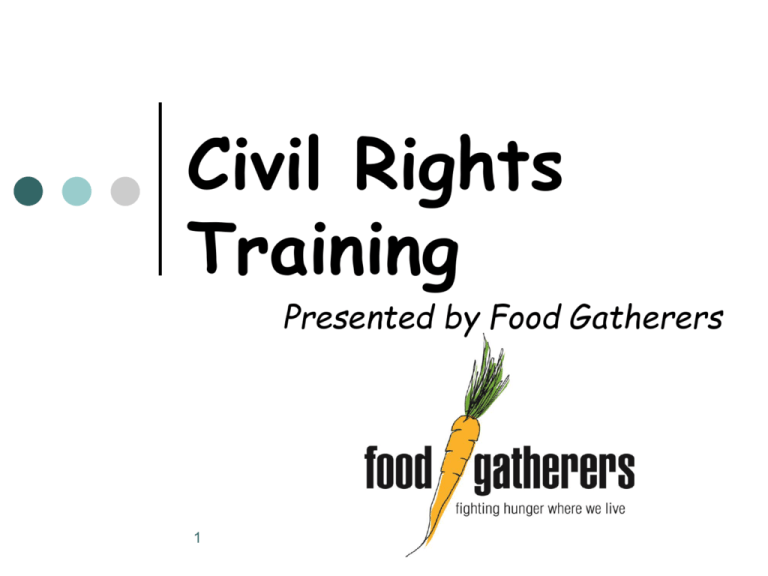
Civil Rights Training Presented by Food Gatherers 1 Your Organization’s Civil Rights Responsibilities All Food Gatherers’ partners receive food from the Federal government through: Why does your organization have civil rights responsibilities related to food received from Food Gatherers? 2 USDA Commodities Program The Emergency Food Assistance Program (TEFAP) Commodity Supplemental Food Program (CSFP) Commodity Distributions to Charitable Institutions Summer Food Service Program (SFSP) ….because some of the food (but not all) originally came from the Federal government! Civil Rights & Food Every human being has the right to have enough nutritious food to meet his/her needs. No person should be denied food or receive unequal treatment because of their: Race Color Sex Age Disability National origin Non-discrimination is the law! 3 Civil Rights Required Training Topics 4 Collection and use of data about consumers Effective ways to notify the public How to file a civil rights complaint How compliance is reviewed Consequences of not following civil rights laws Accommodations for people with disabilities Language assistance for people who have limited English language skills Conflict resolution Customer service Annual Civil Rights Training All people who work or interact with program applicants or participants and those who supervise frontline staff that work with US Department of Agriculture (USDA) funded programs must receive Civil Rights Training once a year. This includes: • Volunteers • Servers • Supervisors It is everyone’s responsibility to eliminate discrimination. Training can be provided in different ways: 5 In person Online, etc. What Are “Civil Rights”? Rights of personal liberty Guaranteed to U.S. citizens by the 13th and 14th Amendments of the U.S. Constitution and by acts of Congress 14th Amendment • “Nor shall any State deprive any person of life, liberty, or property, without due process of law; nor deny to any person within its jurisdiction the equal protection of the laws.” 6 Other Laws: Civil Rights Act of 1964, Americans with Disabilities Act, Age Discrimination Act, Civil Rights Restoration Act of 1987. Goals of Civil Rights 7 Equal treatment for all people under the law. For people to know their rights and for institutions/ organizations to uphold their responsibilities. Elimination of barriers that prevent or stop people from receiving services. Dignity and respect for all people. Types of Discrimination Unequal Treatment Unequal Impact When an action or rule has different outcomes for different groups of people. Reprisal/Retaliation 8 Being treated differently because individual belongs to a certain group. Receiving negative treatment due to an individual’s prior civil rights activity or for filing a civil rights complaint. Protected Classes What is a protected class? Protected classes in TEFAP/CFSP programs are: Any person or group of people who have characteristics for which discrimination is prohibited by law. Race Color National Origin Age Sex Disability Religion Political Belief Protected classes vary for different Federal 9 programs. Equal Opportunity for Religious Organizations Faith-based organizations: 10 Have equal access to USDA funding as other non-profits. Are eligible to participate in USDA programs regardless of their religion, religious belief, character, or affiliation. Can use space in their facilities for USDA programs without removing religious art, symbols, or scriptures. Protecting Consumers When an organization receives USDA food or funding… 11 They ARE NOT allowed to discriminate against a consumer or prospective consumer. USDA food, funds, and programs ARE NOT to support worship, religious instruction, or proselytizing. To do so violates your membership agreement. Collection and Use of Data USDA may require that your organization… This data must be: 12 Collects racial and ethnic data on your consumers. Kept secure Kept confidential Access ONLY allowed to authorized personnel Records must be maintained for 3 years after the completed fiscal year, plus the current fiscal year. What is the Purpose of Data Collection? Data can: 13 Help determine if service-eligible individuals are actually using the services. Reveal if certain racial or ethnic groups are not receiving services. Improve outreach efforts to inform underserved groups. Racial and Ethnic Data Collection Guidelines Respect for individual dignity should guide the process of collecting data on race and ethnicity. Ideally… Consumer should self declare all racial and ethnic categories that apply to her/him. However… Consumer may refuse to self declare or the situation may make self declaration impractical Then the data collector may record racial and ethnic data based on their perception. 14 Public Notification & Outreach “And Justice for All” poster Inform the public and local community organizations about your services. Use different types of media for outreach Prominently displayed Especially where meals/food is distributed to consumers Brochures TV ads Radio ads Know the primary languages used by your consumers Provide information and outreach in these other languages 15 Public Notification and Outreach Convey that your services are open to everyone Indicate this on outreach materials Use photos and graphics that show diversity in race, age, ability, etc. Target outreach to underserved populations Media • Ethnic radio stations • TV channels • Newspapers Community events • Distribute information at local organizations, stores, and places of worship 16 Outreach materials MUST be easy for consumers to read and understand! Non-discrimination Statement “In accordance with Federal law and U.S. Department of Agriculture policy, this institution is prohibited from discriminating on the basis of race, color, national origin, sex, age, or disability. (Not all prohibited bases apply to all programs). To file a complaint of discrimination, write to USDA, Director, Office of Civil Rights, Room 326-W, Whitten Building, 1400 Independence Avenue, SW, Washington, DC 20250-9410 or call (202) 720-5964 (voice and TDD). USDA is an equal opportunity provider and employer.” This statement is REQUIRED to be printed on the following, assuming that they are related to USDA funded programs: Publications Websites Posters Any other materials 17 Non-discrimination Statement in Other Languages The “And Justice for All” poster has the nondiscrimination statement in English and Spanish only Translations for Chinese, Creole, French, German, Hindi, Hmong, Italian, Korean, Polish, Russian, and Vietamese can be found at: http://www.fns.usda.gov/cr/justice.htm 18 Following Civil Rights Rules When are sites reviewed to check if they are following civil rights requirements? 19 BEFORE receiving Federal food/financial assistance WHILE receiving Federal food/financial assistance WHEN significant civil rights concerns affect the delivery of services Resolving Noncompliance to Civil Rights Requirements What to do when individuals fail to comply: STOP discriminatory actions CHANGE organization’s procedures/policies • Helps ensure that discrimination will not occur again • Be sure to inform volunteers and staff about these changes! What can happen if you fail to correct discriminatory practices? 20 Your organization can lose Federal food/financial assistance! Filing Discrimination Complaints How to handle consumers wishing to file a discrimination complaint: Listen politely to the consumer Be aware of the bases for which discrimination complaints may be filed with the TEFAP/CSFP: • Race, color, national origin, age, sex, disability 21 Inform consumers that they should file complaints within 180 DAYS of the discriminatory incident NEVER discourage individuals or groups from filing or voicing complaints. EVERYONE has the right to file complaints. For more information….see handout: How to File a Program Discrimination Send Discrimination Complaints To…. MAIL: USDA Director Office of Adjudication 1400 Independence Avenue, SW Washington, D.C. 20250-9410 or call toll free (866)632-9992 (voice). Individuals that are hearing impaired or have speech disabilities mt contact USDA through the Federal Relay Service at (800)877-8339; or (800)845-6136 (Spanish). USDA is an equal opportunity provider and employer. 22 Access for People with Disabilities Definition of disability with respect to individual according to Americans with Disabilities Act (ADA): 23 a physical or mental impairment that substantially limits one or more of the major life activities of such individual, OR a record of such an impairment, OR being regarded as having such an impairment. Public Accommodation What are considered places of public accommodation? Social service centers Food banks Mandated by the ADA that people with disabilities: Have an equal opportunity to PARTICIPATE in and BENEFIT from goods and services offered by a place of public accommodation This should occur in the most integrated setting that is appropriate 24 Rights of People with Disabilities People with disabilities must be: Admitted or served regardless of their disability Integrated into regular programs to the maximum extent appropriate • However…separate programs for individuals with disabilities are permitted where necessary • Public accommodation may still need to provide opportunity for individuals to benefit from regular program • Ensures equal opportunity 25 Included in regular program Given the choice to accept or decline special services or benefits Allowed to use a service animal if one is required because of a disability. Providing Assistance to People with Disabilities Public accommodations should consult with individuals with disabilities wherever possible to determine what types of aid/services they need. Examples of aid/services: • • • • Clearing hallways and doorways of unnecessary clutter Exchanging written notes with a person who is deaf Helping a person reach an item on the shelf Providing a tape-recorded version of an informational brochure for a person who is blind • Verbally describing an item to a person who is blind • Guiding a person in and out of the building 26 Many of these aids/services can be provided for free or at low cost! Providing Language Assistance Organizations receiving Federal food/financial assistance MUST provide meaningful access to people with limited English language skills by serving them in their primary language. Outreach in other languages is important. Translation/interpretation services must be provided 27 Services must be provided in a flexible way. Shortage of resources does NOT eliminate this requirement. Providing Language Assistance Children who are minors SHOULD NOT be used as interpreters for their families. Be sure staff or volunteer who is interpreting is aware of interpreter ethics: Interpretation is a skill that not all bilingual individuals have. 28 Faithful interpretation Confidentiality Seek professional interpretation services when a staff member or volunteer feels uncomfortable with interpretation responsibilities. Types of Language Assistance If a large proportion of your organization’s consumers speak a language other than English: Interpretation services can be obtained via phone by calling: 29 Have a bilingual staff or volunteer available during meals/food distributions Language Line Services 1-877-886-3885 Document translation services also available Language Identification Card What to do when consumer is seeking language assistance: 30 Ask them to point to their primary language on the language ID card Find staff or volunteer member for interpretation OR seek professional interpretation services See Language ID Card handout for more information Resolving Conflicts Remain calm Open lines of communication Use the L.A.R.A. method: Safety first! 31 Listen carefully to the other person Affirm his/her feelings and concerns Respond with appropriate action Add information, provide options, and followup Seek help if conflict is escalating or if there are threats of violence. Situations & Answers Situation: An organization decides to schedule different food delivery days for people who live on the eastern and western sides of a city. Most of the people who live on the west side are racial minorities. With this delivery schedule, residents of the west side would get their food 2 days later. Is this an example of discrimination? 32 Situations & Answers Answer: There is not enough information to make a determination. This could be discrimination if the service or the quality of the food is poor for one group of people. It could result in charges of impact discrimination. Possible solutions would be to ensure no differences in the quality of service/food or to do a north-south divide for deliveries. 33 Situations & Answers Situation: A complaint was received that a volunteer at a pantry was rude and disrespectful to a consumer seeking services. Are there civil rights issues in this situation? Does it matter if the volunteer and the consumer are of different races, national origins, or genders? 34 Situations & Answers Answer: Based on the information provided, it is not clear if the disrespectful treatment was based on race, color, national origin, age, sex, or disability. If there was such an allegation against the volunteer, then it would not matter if the volunteer and the consumer are of different races, national origins, or genders. People can and sometimes do discriminate against people similar to them. 35 Situations & Answers Situation: Members of an ethnic minority group say an organization is discriminatory because it does not provide them with food that is familiar to them. Is their complaint legitimate? 36 Situations & Answers Answer: It is not discriminatory for an organization to not have food for specific ethnic groups. In fact, it could become discrimination if ethnic food is provided to some groups but not to others. It is best to offer everyone diverse food choices and be sensitive to the dietary needs/habits of your consumers. 37 Situations & Answers Situation: An organization wants to include religious literature with food packages that contain USDA commodity food. Is this allowed? 38 Situations & Answers 39 Answer: Proselytizing is not allowed. Situations & Answers Situation: A person comes to your food pantry and says that the pantry at the church down the street refused to give her food because she is not a church member. Is this a civil rights violation? 40 Situations & Answers Answer: This is not a Civil Rights violation for TEFAP or CSFP but it is a membership agreement violation. 41 Food Gatherers requires program to serve the public – they cannot just serve church members. Please call Food Gatherers and they will discuss the situation with the pantry to ensure that all are served. Situations & Answers Situation: You are collecting racial and ethnic data on the elementary school-aged children who attend your summer lunch program. How do you collect this data? 42 Situations & Answers 43 Answer: In this situation, it is impractical to ask each child about their racial and ethnic identity while they eat lunch. The data collector may record children’s race and ethnicity based on perception. Situations & Answers Situation: A 55 year old person with a disability is denied food through the Commodity Supplemental Food Program and alleges discrimination. He wants to file a complaint. You know that the CSFP is for elderly people 60+ years old and that discrimination is not involved in this situation. What should you do? 44 Situations & Answers Answer: Provide information to the consumer on how to file a complaint. You might explain that Congress wrote the law to limit participation in the CSFP to people age 60 and older. However, you should not discourage the consumer from filing a discrimination complaint if he wishes to do so. 45 Situations & Answers Situation: A pantry that receives Federal financial assistance is located on the 2nd floor of a building and is not accessible to people with wheelchairs. What are some ways to ensure that all people have equal opportunity to benefit from the food pantry? 46 Situations & Answers Answer: Attempts should be made to improve access to the food pantry (examples: install an elevator or move the pantry to the 1st floor). If this is not possible, services can be provided in another manner such as bringing a variety of food items downstairs for the person to choose from or providing home delivery. 47 Situations & Answers Situation: Some people come to the pantry and they do not speak English. You cannot understand them and have no idea what language they are speaking. You give them a note that says they need to return with an interpreter. Is this appropriate? 48 Situations & Answers Answer: Giving someone a note and telling them to come back with an interpreter is highly improper. The pantry needs to provide an interpreter or have information available in the consumer’s primary language. Language identification cards can help you determine what languages your consumers speak so you can have interpreters available on site or call a language line service. 49 Situations & Answers Situation: A pantry manager designates Thursdays as “Asian Day” to make sure there are Chinese and Korean interpreters present on site. The pantry manager also thinks consumers would be more comfortable in a setting where other people speak their language. Is this an example of a civil rights violation? 50 Situations & Answers 51 Answer: Even though the manager had good intentions, Thursdays designated as “Asian Days” could be seen as trying to segregate Asian people. The pantry can advertise times it has interpreters so people can decide to come during those times. The pantry, however, can not require people of a racial/ethnic group or nationality to only come at a certain time because that would be discrimination. Interpretation needs to be provided whenever anyone who needs the service comes to your organization. Customer Service Treat all consumers with honesty and respect. Do not assume you know the circumstances that bring a consumer to your organization in search of assistance. Communicate with consumers: 52 If a consumer is seeking services, then she/he deserves services. HOW they would like to be addressed WHAT kind of assistance they would like from your organization Take Away Points If site has eligibility requirements, they must be: 53 Clearly posted Clearly explained to consumers Your site may refuse service to someone if they pose a safety threat. Anyone has the right to file a civil rights complaint. Non-discrimination is the law! Civil Rights Quiz Click the link below to complete the Civil Rights Quiz: https://docs.google.com/spreadsheet/ viewform?formkey=dE1JTE90ZG1Ba VJrWVFqblRfSFc0dlE6MQ 54 Contact Information Marti Lachapell Director of Agency Relations Food Gatherers marti@foodgatherers.org (734) 761-2796 55 References Language Line Services. http://www.languageline.com Michigan CSFP & TEFAP Civil Rights Training (2007). US Dept. of Agriculture, Food and Nutrition Service. And Justice for All Posters. http://www.fns.usda.gov/cr/justice.htm US Dept. of Justice, Americans With Disabilities Act. http://www.ada.gov 56
